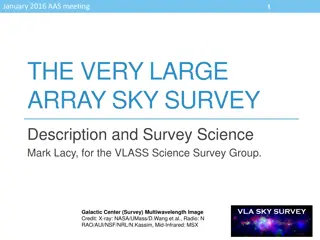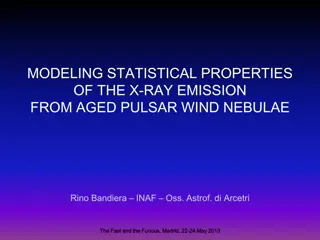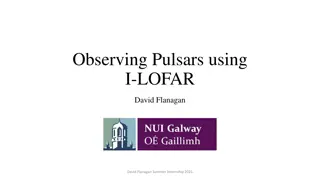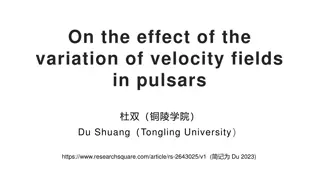Understanding Soft Gamma-Ray Emissions from Pulsar Polar Caps
Soft gamma-ray emissions from the polar cap cascade region are a subject of interest in astrophysics, with studies focusing on the fundamental physical processes of pulsars and potential origins of non-thermal X-ray emissions. Researchers explore the emission processes, polar cap accelerators, casca
0 views • 16 slides
VLASS Sky Survey and Galactic Science Highlights
The January 2016 AAS meeting discussed the VLASS Sky Survey, highlighting survey parameters, science drivers, and the potential for new discoveries in galactic science. Key topics included multiwavelength imaging, Faraday tomography, AGN and galaxy evolution studies, and the search for exotic system
2 views • 9 slides
Linking Soft-Ray Pulsar and Fermi LAT Pulsar Populations
This research presentation explores the connection between the soft-ray pulsar population and the Fermi LAT pulsar population, focusing on observational data and methodologies for increasing the sample size to enhance our understanding of high-energy pulsars. The study outlines the identification pr
0 views • 13 slides
Statistical Properties of X-ray Emission from Aged Pulsar Wind Nebulae
Exploring the statistical trends and evolution of X-ray emission from aged pulsar wind nebulae, including correlations with pulsar characteristics and unexpected expansion findings. Proposed explanations shed light on the intriguing behaviors observed in these cosmic phenomena.
2 views • 18 slides
Exploring Pulsars with I-LOFAR: David Flanagan Summer Internship 2021
Collapsed remnants of supernovae, pulsars emit electromagnetic radiation from their magnetic poles, observed using I-LOFAR at Birr Castle. Learn about Pulsar B1929+10, I-LOFAR operations, and accessing raw data during the research internship supervised by Dr. Aaron Golden.
0 views • 19 slides
Impact of Velocity Field Variations on Pulsar Magnetic Fields
The study explores how variations in velocity fields affect pulsar magnetic fields, highlighting the conversion of kinetic energy to magnetic energy in pulsars. Glitches in these systems can lead to changes in magnetic fields, influencing pulsar emissions. The maintenance of stable magnetic fields a
0 views • 14 slides





